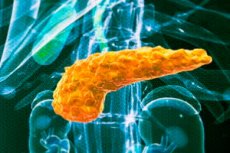
西北大学的研究人员开发了一种新型抗氧化生物材料,未来可以使慢性胰腺炎患者的生活变得更加轻松。
研究的主要发现
该论文“相变柠檬酸大分子对抗氧化性胰腺胰岛损伤,使胰岛能够植入并在网膜中发挥作用”于 6 月 7 日发表在《科学进展》杂志上。
在为患有严重且疼痛的慢性胰腺炎的患者切除胰腺之前,外科医生首先会切除胰岛,这些胰岛是产生胰岛素的组织,被称为“胰岛”,并将其移植到肝脏的血管系统中。移植的目的是保留患者在无需注射胰岛素的情况下控制血糖水平的能力。
不幸的是,这个过程会破坏50%至80%的胰岛,三分之一的患者在手术后会患上糖尿病。手术三年后,70%的患者需要注射胰岛素,这会伴随体重增加、低血糖和疲劳等一系列副作用。
移植新方法
在这项新研究中,科学家将朗格汉斯胰岛移植到肠网膜(一种覆盖肠道的大而扁平的脂肪组织)中,而不是肝脏中。为了给胰岛创造更有利的微环境,研究人员使用了一种具有抗氧化和抗炎功能的生物材料,这种材料在体温下能迅速从液体转变为凝胶。
动物实验结果
在小鼠和灵长类动物实验中,该凝胶成功抑制了氧化应激和炎症反应,显著提高了移植胰岛的存活率和功能。这是首次使用合成抗氧化凝胶来保护移植胰岛的功能。
“尽管近年来胰岛移植技术有所进步,但长期效果仍不令人满意,”该研究负责人吉列尔莫·A·阿米尔(Guillermo A. Ameer)表示。“我们的新型合成材料为胰岛功能创造了一个支持性微环境。在动物试验中,它非常有效,并恢复了正常的血糖水平。”
新型生物材料的优势
该研究的第一作者杰奎琳·伯克补充道:“通过这种新方法,我们希望患者不再被迫在慢性胰腺炎的痛苦和糖尿病并发症之间做出选择。”
角色和前景
对于没有胰腺的患者来说,控制血糖水平等副作用可能是一项终身挑战。胰岛帮助身体维持血糖水平的控制。如果没有功能正常的胰岛,患者必须频繁监测血糖水平并注射胰岛素。
“失去功能性胰岛会给患者带来巨大的负担,”伯克说。“他们必须学会计算碳水化合物,在正确的时间注射胰岛素,并持续监测血糖水平。这耗费了他们大量的时间和精力。”
当前方法存在的问题
但不幸的是,目前的胰岛治疗标准往往导致不良后果。胰腺切除术后,外科医生会分离胰岛,并通过门静脉输注将其移植到肝脏。该手术存在一些常见的并发症。直接与血液接触的胰岛会发生炎症反应,超过一半的胰岛会死亡,而且移植的胰岛还可能导致肝脏出现危险的血栓。出于这些原因,医生和研究人员一直在寻找替代的移植部位。
使用柠檬酸盐溶液的新方法
为了保护胰岛并改善治疗效果,Ameer 采用了其实验室开发的具有抗氧化特性的柠檬酸盐生物材料平台。在细胞培养中,储存在柠檬酸盐凝胶中的小鼠和人类胰岛比储存在其他溶液中的胰岛存活时间更长。当胰岛暴露于葡萄糖时,它们会分泌胰岛素,展现出正常的功能。
整合到组织中
三个月后,人体重新吸收了80%到90%的生物相容性凝胶,此时它已不再需要。“令人惊奇的是,胰岛再生出了血管,”阿米尔说。“人体形成了新的血管网络,将胰岛与全身连接起来。这是一个重要的突破,因为血管能够维持胰岛的活力和健康。”
Ameer计划接下来在动物模型上对这种水凝胶进行更长时间的测试。他还指出,这种新型水凝胶可用于多种细胞替代疗法,包括糖尿病的干细胞疗法。

